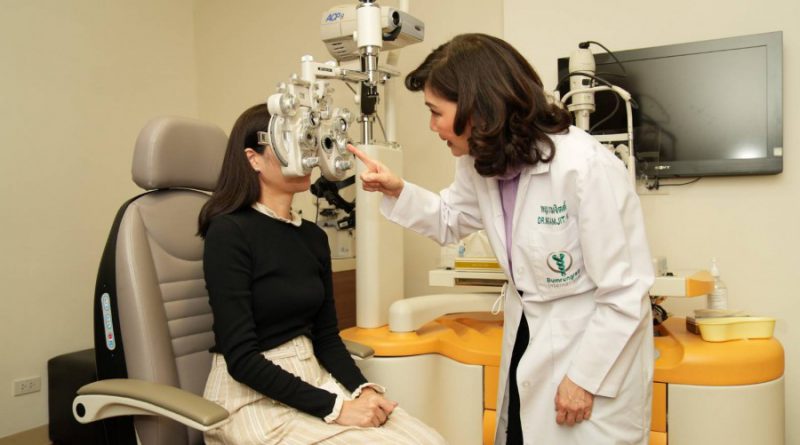Bumrungrad enhances its eye center by opening the Cornea Transplant Center, which is the first private hospital in Thailand.
Bumrungrad enhances its eye center by opening the Cornea Transplant Center, which is the first private hospital in Thailand that provides comprehensive services for the most complex corneal conditions.
According to the World Health Organization, 2.2 billion people experience untreated vision-related health conditions, like myopia, hyperopia, or astigmatism and cataracts. The study of the first rapid assessment of avoidable blindness (RABB) revealed that 92% of blindness in Thai population is preventable and 76.8% is treatable. Moreover, the top 3 causes of blindness are: 1) cataracts 2) glaucoma and 3) corneal disease. Frequently, such vision problems are seen in those aged 50 and over. However, these vision problems are now seen in younger and younger people as time goes on.

Mrs. Artirat Charukitpipat, CEO of Bumrungrad International Hospital, revealed that, “Over the course of Bumrungrad International Hospital’s 42 years of existence, it has continuously pushed the standard of care forward to provide quaternary care and leveraged its centers of excellence to deliver comprehensive care to each and every patient. The Eye Excellence Center is another center of excellence, which stands ready to deliver holistic care to our patients through our team of expert eye doctors & specialists, which are supplemented by the latest innovations in advanced diagnostics and treatments. Together, all of these give the Bumrungrad Eye Excellence Center the capability to treat the most difficult and complex cases of ophthalmic disease. Hence, the Bumrungrad Cornea Transplant Center is an extension of such capabilities, as Bumrungrad is the first private hospital to host such a center providing complete corneal care and treatment and is another proud achievement of Bumrungrad International Hospital.”

Dr. Maytinee Sirimaharaj, Ophthalmologist and Chairperson of Department of Ophthalmology at Bumrungrad International Hospital, stated that “Since eyes are important organs and are made up of many types of tissues, it is necessary for patients to have access to a variety of ophthalmologists. At the Bumrungrad Eye Excellence Center, our patients are cared for by a team of ophthalmologists, who practice a variety of specialties, and deliver holistic care to our patients in the treatment of cataracts, glaucoma, oculoplastic surgery, retinal disease, uveitis, corneal diseases, pediatrics and strabismus, optic nerve disease and refractive surgery with ReLEx SMILE. Bumrungrad offers the stringent physical and mental care; the multidisciplinary teams of the healthcare professionals work closely with ophthalmologists, internists, anesthesiologists, and psychiatrists to deliver the highest quality and safest medical care to our patients. The Bumrungrad Eye Excellence Center has expanded to accommodate higher patient numbers and now encompasses 13 treatment rooms equipped with the latest diagnostic and treatment facilities, which can accommodate the treatment of even the most complex and difficult cases.”
The Bumrungrad Cornea Transplant Center treats all types of corneal conditions, for example, keratitis, corneal edema, keratoconus, hereditary corneal degeneration, corneal ulcers, and corneal transplantation. Each eye condition requires adherence to the treatment timelines because taking action at inappropriate times can have negative effects on patient outcomes, and even put their sight at risk.

Dr. Teeravee Hongyok, Cornea Specialist at Bumrungrad International Hospital, shared that, the cornea is the clear window that sits atop the front of the eye. In all it has 5 layers. The cornea’s main duty is to refract light on the innermost retinal layer to allow the eye to clearly see objects, near and far. So, if one experiences blurry vision, sensitivity to light, frequent changes in visual acuity, severe astigmatism, glare, halo, irritation while wearing contact lenses, or accidental ulceration of the cornea, occluded vision it may be indicative of the onset of a corneal condition, requiring prompt examination, diagnosis, and treatment. The ophthalmologists will carry out thorough eye examinations and use medical tools such as the corneal topographer to evaluate the real shape and curvature of the cornea.
There are many causes of the cloudy, swollen and distorted cornea. The commonly found corneal diseases in other countries are the inherited degeneration of the inner layer of the cornea and keratoconus. Concerning the corneal degeneration, the inner layer of the cornea is essential in keeping the cornea clear. When it is degenerated, the cornea is swollen, becomes thicken, and gets cloudy. Keratoconus is usually related to untreated allergy. The patient always rubs their eyes for a long time, resulting in a weak, fragile, and distorted cornea. In Thailand, the cloudy cornea is more often found because the cornea gets infected from unhealthy working conditions, contact lenses, or not wearing a helmet or an eye protection when riding a motorcycle. Another common case is following the complicated eye surgery. The hereditary or congenital corneal degeneration are also commonly found. All of the conditions cause ulcers, corneal abrasion, swollen cornea, and distorted cornea. It can result in loss of vision, but it can be treated through corneal transplantation to make the cornea clear and enable the patient to see again.

Assoc. Prof. Dr. Ngamjit Kasetsuwan, Cornea specialist at Bumrungrad International Hospital and President of Cornea and Refractive Surgery Society of Thailand, stated that corneal transplantation is a surgical procedure which removes the patient’s damaged cornea and replaces it with a donor cornea. The benefits of corneal transplantation are that it improves patient visual acuity, corneal strength, for those with thin or perforated corneas, and can prevent secondary infection in those with severe corneal infections. Bumrungrad offers surgeries with the microscope-integrated intraoperative optical coherence tomography, which enhances surgical techniques and improves the treatment outcome. The 2 primary methods of corneal transplantation are:
- Penetrating Keratoplasty (or PKP/PK) is a full-thickness, complete transplant of the damaged or diseased cornea with a donor cornea.
- Lamellar Keratoplasty is the removal and replacement of only the diseased or dysfunctional corneal layers, preserving the healthy portion of the patient cornea.
- Anterior lamellar keratoplasty involves replacing only the front parts of the cornea. The advantages of anterior lamellar keratoplasty are preservation of the innermost layers of the cornea, reduction in donor cornea rejection, and fewer complications.
- Endothelial keratoplasty involves the removal and replacement of the inner layer of the cornea. The incision size is limited to 3 – 5 millimeters in length, and complications & recovery time are greatly reduced, approximately in a few weeks, compared to penetrating keratoplasty.
Bumrungrad Cornea Transplant Center also provides the best care for other complex corneal diseases delivered by our corneal experts and high technology. For example, we offer treatment with Excimer laser phototherapeutic keratectomy (PTK), the corneal collagen cross-linking to strengthen the collagen fibrils of the cornea and the insertion of intrastromal corneal ring segments to correct the curvature of the cornea and improve the vision.

The Thai Red Cross Eye Bank reports that patients in need of cornea transplants must usually wait 3 to 5 years, as only 2% of Thais are eye donors. Each year, over 1,000 people are added to the corneal donation waiting list and these numbers are increasing. In contrast, only 600 to 700 people receive a donated cornea each year, while presently there are about 17,000 people waiting for corneal transplants. The long waiting period can greatly worsen the symptoms, prognosis and visual outcome. For example, a diabetic patient with cloudy cornea may develop retinopathy overtime, which cannot be treated properly.
“The Bumrungrad Cornea Transplant Center is another place where patients can waitlist for corneal transplantation in a faster and more convenient manner to reduce the stress on the public health system. Hence, our cornea transplant patients can receive the right care at the right time, allowing them to recover both their sight and quality of life,” Assoc. Prof. Dr. Ngamjit Kasetsuwan concluded.
Bumrungrad International Hospital has been performing organ transplantation for over 30 years and so has developed an expert capacity to perform a wide range of complex transplant procedures, such as kidney, liver and heart transplants. Currently, our corneal transplant procedures have a likelihood of success between 70% and 95%, depending on the diagnosis and severity of diseases. Such a high success rate makes corneal transplantation procedures among the most successful of all organ transplant procedures performed at Bumrungrad. The most important factors affecting the success of corneal transplantation are the fineness of the connection between the patient eye tissue and the donor tissue and the techniques used to perform patient corneal trephination and the shaping of the donor & patient eyes tissues. Successful corneal transplantation requires experienced and skilled ophthalmologists. People 45 years of age and older and those who experiencing ocular conditions should have an annual eye examination.
For more information, please contact the Cornea Transplant Center, Bumrungrad International Hospital, 18th Floor, Building A (Clinic), or call +6620113886 and 1378.




